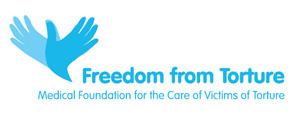Key people Susan Munroe (CEO) Type of business Charity | ||
 | ||
Website www.freedomfromtorture.org Similar Center for Victims of Torture, Physicians for Human Rights, Coram Children's Legal Ce, OutRight Action International, Human Rights First Profiles | ||
Freedom from torture what we do
Freedom from Torture (previously known as The Medical Foundation for the Care of Victims of Torture) is a British registered charity which provides therapeutic care for survivors of torture who seek protection in the UK. Since it was established in 1985, over 57,000 survivors of torture have been referred to the organisation for help and it is one of the world’s largest torture treatment centres.
Contents
- Freedom from torture what we do
- Welcome to freedom from torture youtube page
- History
- Treatment provided
- Statistics
- Medico Legal Reports
- Funding
- References
Freedom from Torture provides medical and psychological documentation of torture, a range of rehabilitation therapies, including psychotherapy, individual and family counselling, physiotherapy and complementary group work as well as practical advice and support. It trains health, legal and policy professionals throughout the UK to work with the complex needs and rights of torture survivors.
A key area of Freedom from Torture's work is to advocate for torture survivors and to ensure states responsible for torture are held accountable. It works to guarantee the human rights of survivors nationally and internationally.
Freedom from Torture also supports Survivors Speak OUT (SSO), the UK’s only torture survivor-led activist network. SSO uses first-hand experience to speak out against torture and its impacts, advocates for the rights and rehabilitation of torture survivors worldwide, and provides a voice for torture survivors who have been silenced by fear or torture. All members are former Freedom from Torture clients.
Welcome to freedom from torture youtube page
History
Freedom from Torture began in the early 1980s, as part of the Medical Group of Amnesty International.The organisation was set up to improve existing health services for torture survivors in the UK. This work initially took the form of campaigns against violations of human rights and the documentation of evidence of torture by volunteer health professionals and senior medical specialists as a reaction .
In 1985, under the leadership of Helen Bamber, the organisation was established as a registered charity. It provided medical treatment, counselling and therapy to torture survivors and documented evidence of torture using the Istanbul Protocol. Sponsorship came from the heads of the Royal College of Physicians, Royal College of Psychiatrists and Royal College of Surgeons of England.
It worked at first in two rooms in the former National Temperance Hospital, off Hampstead Road in north-west London. By 1990, the organisation was treating 750 clients and then moved to a building in Grafton Road, Kentish Town.
The organisation began a regional programme in late 2003 with the opening of a centre in Manchester, treating clients living in the north-west. This followed the Government's Dispersal scheme on BBC News , which saw asylum seekers relocated outside London.
In 2004, the London headquarters moved into a £5.8m treatment centre in Isledon Road, Finsbury Park. The building was purpose-built by architect Paul Hyett. Freedom from Torture’s Scotland centre opened in Glasgow in 2004, followed by the Newcastle centre in 2006 and the Birmingham centre in 2009. These regional centres were opened to treat torture survivors who had been dispersed outside London.
Freedom from Torture's chief executive officer is Susan Munroe.
Treatment provided
Freedom from Torture provides a range of services for its clients. These include medical consultation, examination and forensic documentation of injuries through medico-legal reports, psychological and physical treatment and support, and practical help.
The organisation employs over 200 staff and volunteers in the five centres, including medical doctors, caseworkers, counselors, legal advisers, physiotherapists, psychotherapists, psychologists, interpreters, child and family therapists and group workers.
Over 75 interpreters are employed, who work in 50 different languages and dialects.
Statistics
Since the organisation was founded in 1985, the organisation has received around 52,000 referrals.
In 2011, Freedom from Torture’s five centres received 1,546 referrals for individuals from 86 different countries. For the same year, 69.7% of referrals were from the following 10 countries: Iran (267), Sri Lanka (233), Afghanistan (108), Democratic Republic of Congo (90), Turkey (79), Pakistan (56), Uganda (52), Iraq (48), Nigeria (45) and Sudan (39).
99% of Freedom from Torture clients are asylum seekers or refugees, who have fled torture and persecution usually in their home countries.
Medico-Legal Reports
The organisation's Medico Legal Report Service accepts referrals from torture survivors, their friends and family, GPs, solicitors, refugee community organisations or any other voluntary or statutory sector body.
Medico-legal reports provide detailed evidence of the extent of a torture survivor’s injuries and trauma. Freedom from Torture's team of clinical staff apply international standards for documenting torture in these assessments.
Funding
Freedom from Torture is an independent registered charity and the only organisation in the UK which is exclusively dedicated to the care and treatment of torture survivors.
They rely on donations from individuals for almost three quarters of their funding. They raise income using a variety of methods and from a variety of sources so that they can maintain a safe and sustainable framework that allows them to continue providing vital services to survivors of torture.
